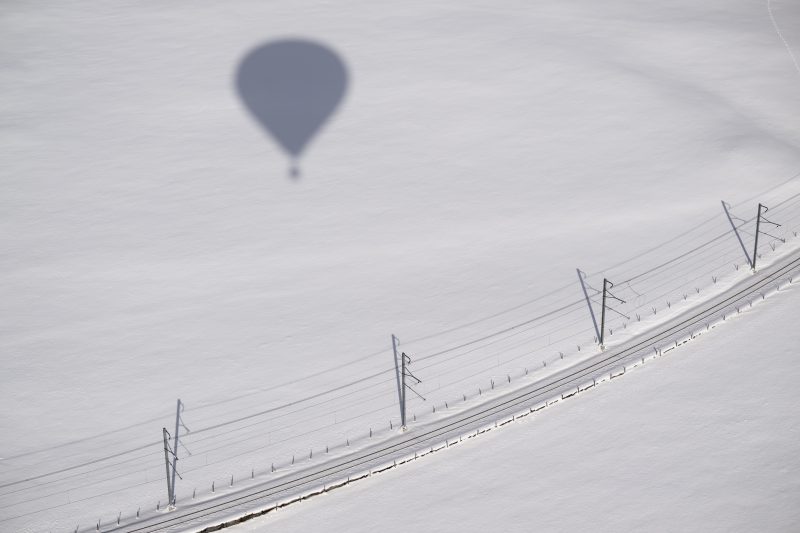Americans love a good balloon story.
Remember in 2009 when that kid in Colorado was in a balloon drifting around until it turned out he wasn’t? That was one of the signal moments of the early social-media era, a point of discussion and speculation that dominated the national conversation for days on end. Remember, um, “Up”? Pretty good movie.
And now we have this balloon floating somewhere over the United States. Originating in China, per a statement from officials in that country, it’s either a weather balloon that drifted off course (per those officials) or an espionage-focused challenge to American hegemony that derives directly from President Biden’s weakness (per various Republicans on Fox News).
Whichever of those two things is true — or if, I suppose, there’s some third option — it’s fascinating to think about: this big balloon just floating up there somewhere, capturing the public imagination. This very old technology put to a very modern use. This thing that we associate with children’s parties, now potentially deployed as a tool of our eventual destruction. It’s poetry.
So let’s now talk about how you can make a floating metaphor of your own.
As it turns out, releasing giant balloons into the upper atmosphere is not only not an activity constrained to international spycraft but is instead a hobby for any number of Americans. If you go on YouTube, you can find videos of people who’ve filled large weather balloons with helium, attached cameras and released them.
Here is one such example, from an amateur astronomer.
This activity is so common, in fact, that it’s a project undertaken in elementary school science classes. The primary challenge, in fact, seems to be retrieval of the payload camera once the balloon inevitably bursts (due to decreased air pressure at higher elevations). Generally, the rigs include some sort of GPS device facilitating that retrieval.
Enough with that background. Let’s get you prepared to join ranks with nefarious international spymasters and also Mrs. Cromwell’s second-graders.
My sources for this story are twofold: an instructional video from YouTube (of which there are many) and the detailed delineation of required components and steps articulated at Instructables. I have not yet constructed such a device, having little need for photographs of Montana’s nuclear missile silos, but this is admittedly something that I’ve considered doing in the past because I am a nerd.
First, you need a weather balloon. Instructables recommends a 600-gram balloon, which you can obtain online from sites like Scientific Sales for about $50.
Next, you need helium. As you are probably aware, you can get this all over the place. Walk into Party City and ask them to point you to the spy aisle. Or you can order online; this retailer offers 81 cubic feet (more than Instructables’s recommended 70 cubic feet) for about $150. (There are other costs, too, depending on if you buy the tank or need the proper valves. We’ll let you and the Espionage Manager at Party City figure that out.)
Just with that, of course, you’ve got enough to get your balloon in the sky. But this isn’t going to be great for spying unless you purchased a sentient, talking balloon that can describe what it saw. (That increases the price significantly.) So you’ll also want a payload that includes a camera.
Instructables recommends using a disposable foam cooler ($5 at Walmart), spray-painted in a bright, neon color ($9 at Amazon) to facilitate retrieval. Make a little hole in it, tape in a GoPro camera (a knockoff costs about $100) and add a GPS tracking device (an Apple AirTag costs $30). Filling the cooler with aluminum foil ($9 at Wegman’s) helps the balloon and its payload be more detectable by aircraft, who it is recommended you not inadvertently down.
You’ll also need some rope to tie the cooler to the balloon ($7 at Amazon) and a parachute so that the camera survives its adventure (this $18 one from Amazon is smaller than what’s recommended, but you can do a little legwork here yourself, for Pete’s sake).
Once you have everything you need, you can start assembling it. I’m not going to just replicate the Instructables instructions, which you can read for yourself. I will note, though, that it recommends using latex gloves when handling the balloon so that oil from your skin doesn’t damage the latex. This leads me to the amusing concept of an action movie in which a Chinese spy balloon is destroyed by a hotshot fighter pilot giving it an ungloved high-five. (All rights reserved.)
Perhaps the most important consideration once you’re ready to go is what the wind is doing. This balloon will be light and it will be very high in the air and therefore subject to natural forces beyond your control. It is this externality that the Chinese officials insist is responsible for their balloon’s current location, but I’m sure you can figure this out more easily than the Chinese academics who are getting blamed for this weird geopolitical situation. There are lots of tools to do so (like this calculator of how high your balloon will go) and there are lots of people who’ve done this before (like weather observers who actually do release hundreds of weather balloons every day) (this is why they are called “weather balloons”).
Absolutely smooth launch @NWSJacksonville. One of those few jobs left in meteorology that don’t require you to sit behind a computer. pic.twitter.com/b1QZkniC2x
— Robert Speta (@RobertSpetaWX) August 2, 2022
These balloons actually help us understand the speed of the wind at higher altitudes, as well as other weather phenomena. The government publishes data on current wind speeds, up to 53,000 feet, which you might consider reviewing before you launch your own balloon. Is it useful to you to know that the wind speed at that highest altitude is about 57 knots near D.C. as I write? If so, you’re welcome.
Eventually, everything comes together and you release your balloon. In short order, you’ve joined the ranks of the world’s covert agents, gathering critical, detailed information on nearby backyards and parks in your vicinity. Feel free to reach out to foreign actors and see how much they’ll give you for this data.
I will end with a caveat. Two Christmases ago, I got my kids an Estes model rocket of the sort I had when I was a kid. We went outside to launch it, which was a success. It reached its peak altitude and its parachute deployed. It then landed in the neighbor’s tree, beyond my reach. It remains there to this day, to my occasional embarrassment.
My point is this: You may end up with a fluorescent cooler stuck outside your house for a few months, a sure sign to government agents that you are a spy. Or maybe that you are an elementary school teacher. I’ll let you figure out which way you want to go with it.








